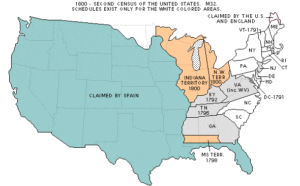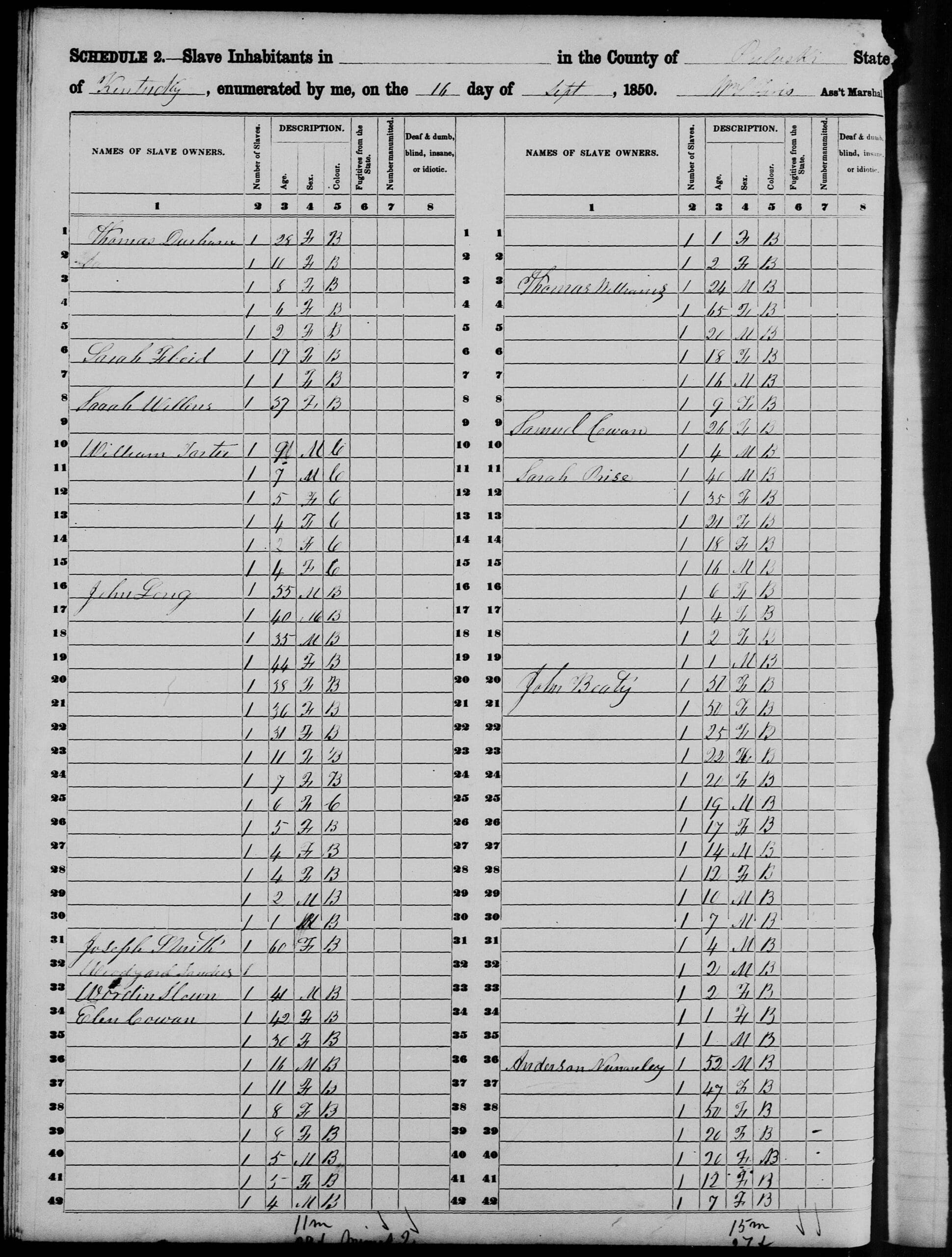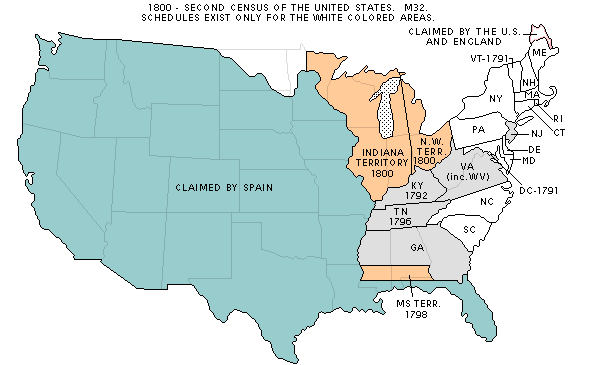In 1798, Pulaski County was created from parts of Green and Lincoln Counties. It was first inhabited by Revolutionary War veterans who chose to honor their fallen comrade, Casimir Pulaski, a native of Warsaw, Poland and hailed as the “Father of the American Cavalry.” Unfortunately, Pulaski lost his life during the Battle of Savannah in 1779. Interestingly, there are currently seven counties named Pulaski across the US. The specific location in Kentucky was designated Somerset when it became the county seat in 1801, after settlers from Somerset County, NJ named it as such.
Pulaski County had a population of 3,161 in 1800, according to the “Second Census” of Kentucky: 2,928 whites, 232 enslaved, and one free colored. The number of slave holders, slave enslaved, free Blacks, and free Mulattoes for 1850-1870 has increased to 15,831 by 1860, according to the U.S. Federal Census. This does not include the enslaved.
1850 Slave Schedule
- 269 slave owners
- 1,193 Black slaves
- 7 Colored slaves [one owned by John Long and six owned by William Tarter]
- 105 Mulatto slaves
- 15 free Blacks [last names Buster, Madnel, Moderal, Simpson, Weaver, and Wellens]
- 12 free Mulattoes [most with last name Roper, and one Drew, Hays, Keeney, and Simpson]
1860 Slave Schedule
- 285 slave owners
- 1,150 Black slaves
- 180 Mulatto slaves
- 18 free Blacks [most with last names Buster and Moderal]
- 34 free Mulattoes [most with last names White and Stevens]
1870 U.S. Federal Census
- 946 Blacks
- 133 Mulattoes
- About 33 U.S. Colored Troops listed Pulaski County, KY as their birth location.
SOURCE: “Pulaski County (KY) Enslaved, Free Blacks, and Free Mulattoes, 1850-1870,” Notable Kentucky African Americans Database, accessed January 19, 2024, https://nkaa.uky.edu/nkaa/items/show/2530.
Pulaski County, Kentucky Slave Schedule, September 11, 1850
Below is an image of page 5 of digital archives of the 1850 census on the 11th day of September 1850.
On this page, you will see the name William Tarter on Line 10, who is listed above.
See the full Pulaski County, Kentucky 1850 Slave schedule at https://www.familysearch.org/ark:/61903/3:1:S3HT-69PQ-BMT?wc=MJC8-BZ5%3A1042937101%2C1042977501%2C1042977502&cc=1420440
SOURCE: “United States Census (Slave Schedule), 1850 .” Database with images. FamilySearch. http://FamilySearch.org: 23 December 2023. Citing NARA microfilm publication M432. Washington D.C.: National Archives, n.d.
The 1800 and1850 United States Census and the "Second Census" of Kentucky
1800 Census Questionnaire
There are no originals of the 1800 census from Georgia, Kentucky, New Jersey, Tennessee, or Virginia, nor from Indiana, Mississippi, or the Northwest Territories, except for Washington County in the Northwest Territories. However, there is a publication entitled “Second census” of Kentucky, 1800″ by Garrett Glenn Clift, which is an enumeration of tax payers privately compiled and published in the 79 manuscript volumes extant of tax lists for the 42 counties of Kentucky in 1800. This publication can be found at the University of Kentucky Libraries: Special Collections.
From 1800 to 1820, the states provided schedules of varying size and typeface. The 1800 schedule of inquiries called for the name of the county, parish, township, town, or city where the family resides; the name of the head of the family; a statement for each family of the number of free White males and females under 10 years of age, of 10 and under 16, of 16 and under 26, of 26 and under 45, and 45 years and upward; the number of all other free persons (except Indians not taxed); and the number of slaves.
Although instructions to Marshals were not available for the 1800 census, this author thought it interesting and necessary to include the instructions specific to slaves for the year 1850 since that is the first slave schedule listed at the beginning of this page for Pulaski County, Kentucky.
The following are instructions to the “Marshals and Assistants” for the 1850 United States Census.
1850 Questionnaire – Slave Inhabitants
(12 1/2″ X 17 1/2,″ printed on two sides with space for 40 entries on each side) The 1850 questionnaire relating to slave inhabitants collected the names of slave owners; number of slaves; the slaves color, sex, age, and whether deaf and dumb, blind, insane, or idiotic; the numbers of fugitives from the state; and the number manumitted.
Explanation of Schedule 2—Slave Inhabitants
This schedule is to be filled up in the following manner: Insert in the heading the number or name of the district, town, city, and the county or parish, and of the state in which the slave inhabitants enumerated reside, and the day of the month upon which the enumeration was taken. This is to be attested on each page of each set, by the signature of the assistant marshal. The several columns are to be filled up as follows:
1. Under heading 1, entitled ‘‘Name of slave holders,’’ insert, in proper order, the names of the owners of slaves. Where there are several owners to a slave, the name of one only need be entered, or when owned by a corporation or trust estate, the name of the trustee or corporation.
2. Under heading 2, entitled ‘‘Number of slaves,’’ insert, in regular numerical order, the number of all slaves of both sexes and of each age, belonging to such owners. In the case of slaves, numbers are to be substituted for names. The number of every slave who usually resides in the district enumerated is to be entered, although he may happen to be temporarily absent. U.S. Census Bureau 11 The slaves of each owner are to be numbered separately, beginning at No. 1, and a separate description of each is to be given. The person in whose family, or on whose plantation, the slave is found to be employed, is to be considered the owner—the principal object being to get the number of slaves, and not that of masters or owners.
3. Under heading 3, entitled ’’Age,’’ insert, in figures, the specific age of each slave opposite the number of such slave. If the exact age can not be ascertained, insert a number which shall be the nearest approximation to it. The age of every slave, either exact or estimated, is to be inserted. If the slave be a child which, on the 1st of June, was under 1 year old, the entry is to be made by fractional parts of a year; thus, one month old, one-twelfth; two months, two-twelfths; three months, three-twelfths; eleven months, eleven-twelfths; keeping ever in view, in all cases, that the age must be estimated at no later period than the 1st of June.
4. Under heading 4, entitled ‘‘Sex,’’ insert the letter M for male, and F for female opposite the number in all cases, as the fact may be.
5. Under heading 5, entitled ‘‘Color,’’ insert in all cases, when the slave is black, the letter B; when he or she is mulatto, insert M. The color of all slaves should be noted.
6. Under heading 6 insert, in figures, opposite the name of the slave owner, the number of slaves who, having absconded within the year, have not been recovered.
7. In column 7, insert opposite the name of the former owner thereof, the number of slaves manumitted within the year. The name of the person is to be given, although at the time of the enumeration, such person may not have held slaves on the 1st of June. In such case, no entry is to be made in column No. 2.
8. Under heading 8, entitled ‘‘Deaf and dumb, blind, insane, or idiotic,’’ the assistant should ascertain if any of these slaves be deaf and dumb, blind, insane, or idiotic; and if so, insert opposite the name or number of such slave, the term deaf and dumb, blind, insane, or idiotic, as the fact may be. If slaves be found imprisoned convicts, mention the crime in column 8, and the date of conviction before the number in vacant space below the name of the owner. The convict slaves should be numbered with the other slaves of their proper owner.
SOURCE:
Measuring America: The Decennial Censuses From 1790-2000. https://www.census.gov/history/pdf/measuringamerica.pdf




